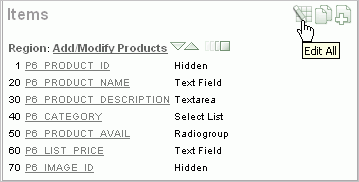Using the Edit All Icon to Edit Multiple Items
You can edit multiple items at once by clicking the Edit All icon on the Page Definition. The Edit All icon resembles a small grid with a pencil on top of it.

Description of the illustration edit_all_item.gif
Clicking the Edit All icon displays a series of pages that enable you to edit multiple items simultaneously or view a history of recent changes.
Topics:
Page Items
Item attributes control how items display on a page. You can use the Page Items page to edit the sequence, field label, template, region, and overall position for all items on a page.
A Navigation bar displays at the top of the page. Use the Page field to navigate to another page. To limit the display to just items in a specific region, make a selection from Show Regions list.
The Page Items page displays items in an editable report. Table: Editable Attributes on Page Items describes each editable attribute.
Editable Attributes on Page Items
| Attribute | Description |
|---|---|
|
Sequence |
Specify the display sequence for this component. The sequence determines the order of evaluation. |
|
Prompt |
Enter the label for this HTML form element. You may include HTML, JavaScript, and shortcuts. You can also use the substitution string #CURRENT_ITEM_NAME# to obtain the name of the item associated with this label. |
|
Field Template |
Determines the a label template. Label templates enable you to define the user interface attributes in a central place and share that definition among many labels. |
|
Region |
Defines the region in which the item displays. All items must be in a region. |
|
New Line |
Determines whether this item displays on the same line as the previous item or whether it displays on the next line. Items are laid out in an HTML table. Select Yes to have an item display as the first field in a new row in the table. |
|
Width |
Specifies the length (in characters) of the form element that displays for this item. |
|
Height |
Specifies the height (in lines) for text areas and multi select lists. |
|
Column Span |
Items are laid out in HTML tables. This property defines the value to be used for the |
|
Row Span |
Items are laid out in HTML tables. The attribute determines the value to be used for the |
Edit the appropriate attributes and click Apply Changes.
Item Help
Use the Item Help page to edit item help for all items on a page. You can avoid repeating the same Help text in multiple locations by subscribing to another item.
To edit item Help:
-
Navigate to the appropriate Page Definition. See "Accessing a Page Definition".
-
Under Items, click the Edit All icon.
-
Click Item Help.
The Item Help page appears.
Use the Navigation bar at the top of the page to narrow or broaden the display. Available options include:
-
Page - Select or enter a new number and click Go.
-
Search - Enter a case insensitive query and click Go.
-
Show - Select whether to display All, Subscribed, or Unsubscribed Help text.
-
All Pages - Select to run the search query on all pages in the application.
-
Current Page - Select to restrict the search query to the current page.
You can also use the arrows in the Navigation bar to scroll through the application pages.
-
-
To subscribe to an existing Help item, make a selection from Subscribed To.
-
To edit help for a specific item, click the item name.
On the Edit Help page:
-
Reference Master Item Help From - (Optional) Select a existing item Help topic to subscribe to.
-
Help Text - Enter or edit the Help text for this item.
-
Click Apply Changes.
-
-
Click Apply Changes.
Reassign Region Items
Use the Reassign Region Items page to assign items to a new region.
To Reassign Region Items page:
-
Navigate to the appropriate Page Definition. See "Accessing a Page Definition".
-
Under Items, click the Edit All icon.
-
Click Reassign Region Items.
The Reassign Region Items page appears.
Use the Navigation bar at the top of the page to narrow or broaden the display. Available options include:
-
Page - Select or enter a new number and click Go.
-
Show Regions - Select a region to display and click Go.
-
-
To reassign an item to another region:
-
Select the items to reassign.
-
From Assign to Region, select a new region.
-
Click Reassign Region Items.
-
Delete Multiple Items
Use the Delete Multiple Items page to delete multiple items at once.
To delete multiple items:
-
Navigate to the appropriate Page Definition. See "Accessing a Page Definition".
-
Under Items, click the Edit All icon.
-
Click Delete Multiple Items.
The Delete Multiple Items page appears.
Use the Navigation bar at the top of the page to narrow or broaden the display. Available options include:
-
Page - Select or enter a new number and click Go.
-
Show Regions - Select a region to display and click Go.
-
Forward (>) and Next (<) buttons - Display the previous and next page.
-
-
To reassign an item to another region:
-
Select the items to reassign.
-
From Assign to Region, select a new region.
-
Click Reassign Region Items.
-

